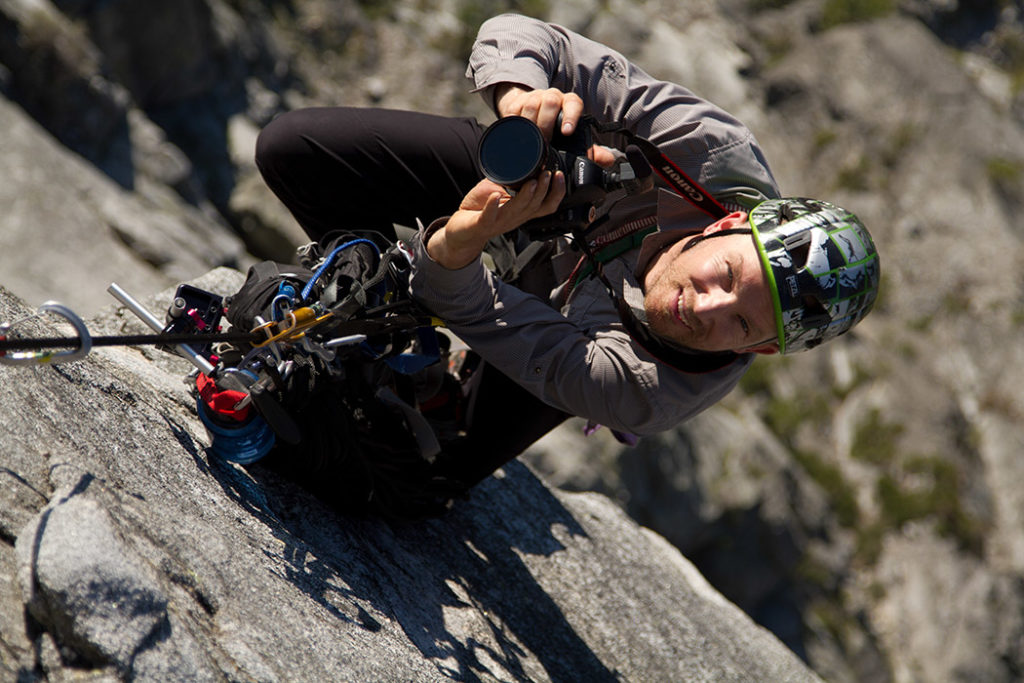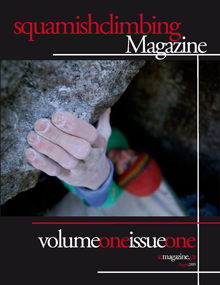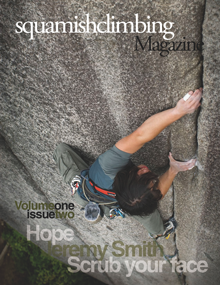The Vancouver International Mountain Film Festival starts its 2018 November Series run next week from November 13th-18th. This year, the festival is bookended by two different films co-directed by filmmaker Pete Mortimer.
Pete Mortimer is a climber and Filmmaker based in Boulder, Colorado. After making his first film in 2001, Pete went on to pursue a career in filmmaking, breaking out with his films Front Range Freaks (2003), Return2Sender (2005) and First Ascent (2006). In 2007, Mortimer teamed up with Chris Sharma to film his attempts on Es Pontas in Mallorca, captured in the film King Lines (2007) which later led to his work with Josh Lowell. Together, Mortimer and Lowell created the Reel Rock series, a collaboration of climbing films that has defined the climbing film landscape, featuring some of the best films in climbing. Mortimer and his production company, Sender Films, have received numerous awards for their work on a number of culturally significant climbing films, including King Lines (2007) and Valley Uprising (2014).
Co-directed with Josh Lowell, Mortimer’s latest film ‘The Dawn Wall’, has taken the climbing community by storm and was their most ambitious project yet, following Tommy Caldwell and Kevin Jorgensen as they attempted to free The Dawn Wall on Yosemite’s El Capitan.
We had a chance to catch up with Pete Mortimer this week and here is what he had to say.
Hi Pete, first off thanks for taking the time to chat with us. We had a chance to watch The Dawn Wall this week and it nothing short of amazing! What an accomplishment by everyone involved! What is it like to see this project complete after six years of filming and two years of editing?
It’s rewarding to share this film with people. Tommy and Kevin’s story is so inspiring, and there are great lessons to gain from their journey, so it’s really fun to hear people’s responses to the film and how it has affected them.
I remember being in a tiny office watching the livestream when Tommy and Kevin topped out and even there by myself it was an emotional moment. What was it like when that happened and can you describe what you were feeling at that time?
It was truly emotional and also kind of surreal. We had been following this journey for so many years, and up until the last week, it was a pretty intimate story. To go from just us, to having people across the world watch them top out, was incredible. I think it is a testament to the audacity of this climb, the brotherhood they built, and their dedication.
We were not convinced that Kevin was gonna make it, and we were definitely having that conversation amongst ourselves as to whether we thought Tommy should go up alone with Kevin belaying, or how long they should keep at it. Luckily, we weren’t involved in their decision making process, and they worked it out pretty well on their own.
I want to go back to the beginning when you decided to take on this project. What were your initial thoughts and did you imagine that it would have been a six year commitment?
There was a sense from the beginning that this might never happen and that if it did happen it was going to take a long time for all the pieces to come together. But, we were with Tommy and he was putting all his chips on the table, so it was fun as filmmakers to just follow along for the ride and see where it went.
With a six year span of gathering footage, the narrative of the story must have changed from time to time in terms of how you wanted to tell this story. Can you tell us a bit about that process?
I’m not sure our thoughts on the narrative changed but the story just kept getting richer. As with any journey, the more sacrifice and commitment and the deeper the journey goes, the more meaningful it becomes. We kept the same strategy of filming the whole time, which was to shoot as much as possible, stay out of their way, and let this incredible story unfold. After the climb was complete, we wrestled with how to put the film together and we spent three years in post production — that was the more gruelling creative part, figuring out how to weave all the narrative threads together.
Three years in post production is a long time. Were there any other issues that came up when trying to get this film out?
Most of that time was truly spent editing. We were also working with Red Bull media House (who we sold the film to) on distribution plans, but the majority of our time was spent in the edit room, shifting the pieces of the puzzle around, screening for different people, trying to get the whole film to flow together with all the different parts. Because the film narrative jumps back and forth in time, there was an added challenge of making all the pieces fit, and that added more layers of complication to the edit.
When having to wait for so long to release a film, other projects must come into play. How do you keep the focus on one project while juggling another?
Yes there is a bit of juggling with other projects, but we always deal with that as we run commercial projects, documentaries, REEL ROCK films and more simultaneously all the time. We have a pretty solid in-house team of producers and editors who help us keep everything on track, and allow the creative teams to put their focus where it needs to be.
For this project and others, does a narrative usually present itself or do you go into a project with some sort of assumptions about how it is going to go beforehand?
The narrative for this film was pretty clear on a base level: one of the great climbers of our generation is driven by life events to go all in on the ultimate climb. It’s either gonna be a defining success or a spectacular failure, but either way its going to be fascinating to watch this unfold.
Were there any narrative threads that didn’t make the film but you wish that they did?
There were a lot of threads that didn’t make the final cut. Most of those were in the seven years of Tommy and Kevin trying the climb and everything they went through personally as well as on the wall during that time, all the failed attempts etc. We had so much footage and so many mini dramas that played out up there that in the end we had to keep the focus on the drama within the 19 day ascent. There were also story threads with both of their personal lives that we wanted to flesh out more but in the end were not as germane to the key story as what stayed in the film. Core climbers will notice that we don’t tell the story of pitch 14, which is the first half of the traverse and is equally as hard as pitch 15. You see footage of it throughout the film in the failed attempts but on the actual ascent they both did it rather quickly so we just condensed the traverse into pitch 15 where Kevin struggled.
After watching the film, I was somewhat surprised that the story was so Tommy specific, following his journey from a point much further back than the inception of The Dawn Wall. How did you and Josh come to the decision to present the story this way and was it a difficult decision to do so?
This was not a difficult decision because we knew that to truly understand The Dawn Wall, and to understand why someone would dedicate so much to a single rock climb, you had to know all the events that had lead Tommy to this point where he was willing to go all in on the climb. Regarding Kevin, we felt his major conflict came on the final climb itself, so we went lighter on his backstory and let you really get invested in him more deeply when he has to perform in an intense moment.
The film touched closely on the separation of Tommy and Beth Rodden and the impact that this had on Tommy. Was it obvious that this part of the story needed to be included and how does a team navigate around such a personal event while being so close to the people involved?
This also felt clear to us, because Tommy seems like someone who when he was younger was really good at dealing with physical adversity, but was less experienced in dealing with matters of the heart. After tommy and Beth’s separation, it seemed like Tommy needed a relationship with something stable and on his terms, and that became The Dawn Wall. Once he believed he might actually be able to climb The Dawn Wall, he needed a new partner, and that was what Kevin became to him.
Working with Josh Lowell, you both bring different strengths to the table. What do you think are the strengths of both you and Josh while working together and how does it change the dynamic of directing together instead of alone?
We overlap a lot but the big difference is that Josh is a really amazing filmmaker — everything he shoots (with his brother Brett) and edits and has scored, etc, is beautiful and lyrical. I think a lot more about character arcs and structure. But we do overlap on everything.
A lot of interviews have gone into the filming of the project and some of the crazy techniques involved while working in a park that does not allow drones, such as using huge static ropes to get far away from the wall. How have those techniques influenced you as a film maker on other projects?
Its important that we try to stay at the front of the curve in terms of filming, because climbing is visually stunning and we shoot in dramatic locations. Filming The Dawn Wall definitely helped us push ourselves and be more creative on the big walls.
Filming on El Cap obviously requires a huge team of riggers and climbers. How easy or difficult was it to coordinate the team and how many people were involved?
We kept our teams pretty tight over the years and it tended to be the same small crew more or less. The rigging was done by local monkeys who are totally dialled up there. The actual filming was done just by a handful of different shooters.
There are some big moments on pitch 15 and the the sequence capturing this moment is really exhilarating and may be one of the best pitches captured on film. What work went into this pitch and how long did it take to get the editing exactly right?
By that time we had quite a few cameras shooting from the wall and the ground, and it was just a matter of filming every attempt as best we could, and hoping that one of them would be the one. We were able to have one camera just shooting close ups, as we knew those shots would be key in amplifying the drama of the pitch.
I wanted to touch a little on your history and story as a film maker. Can you tell us a bit about what drew you to film making in the first place and how it all started?
I took a video class in college and fell in love with the whole process of making a film, working with people and telling stories through this medium. I was a science major, so this felt liberating. I’d grown up climbing and when I saw Josh Lowell making bouldering videos back east I was inspired to make my own climbing film. Josh and I were geo majors and we climbed together in college. The first film I made is called Scary Faces and it’s about all these things that had influenced me as a kid growing up climbing in Boulder.
After college I knew I wanted to go into film, but I didn’t know anyone in that world. After a few years in New York getting my feet wet, I moved to L.A. for film school. There, I got to see the whole studio system and everyone working in the industry in so many different capacities. I had already made a couple climbing videos and I realized I was in this cool growing niche so I just kept running with it.
For you, what is the most rewarding thing as a film maker and what are some of the struggles that come with such demanding work?
I think sharing The Dawn Wall has been the most rewarding yet. We had all these ideas about the drama of the story, and the bigger themes about what the film means, and how Tommy and Kevin live their lives and relate to each other. People seem to connect with the film as we hoped and that feels really rewarding, like we are putting something meaningful out there. So many people bring their kids to see that film because they see Tommy and Kevin as role models. I love that.
The demanding thing is making every film. We have an amazing team and we are getting good at nailing some aspects of filmmaking, but every story comes with new challenges and you can never think that just because you hit all the marks the film will actually work. There’s always an unknown factor about what makes something special and connects with people, and that’s the hard part.
How has your schooling influenced you as a story teller and looking back, do you think it was an important part of the process for you?
I think being in L.A. at a big film school I was exposed to people who were driven and talented and many of whom have become quite successful. Being around that gives you more confidence that you can do it, that your films can get out there. I also had some great professors who drilled us on analyzing scripts and story structure, and that helps when making a film.
Your style of using stills and illustrations to tell a story has had a huge impact on the climbing film industry. The use of this technique looks seamless but must require a huge amount of technical skill. Can you tell us a bit about when you started using this technique and how it has evolved throughout the years?
I have an old friend Barry Thompson that is a great artist who got into digital effects. We first started animating stills because I wanted to showcase Barry’s talent. We now lean on animated stills as a story telling device in a lot of circumstances. When we made Valley Uprising, we got really into the visual process with Barry and we spent years coming up with the visual palette for that film. It’s such a fun process, and expands your idea of how you can tell a story.
When starting with any narration like this, do you always start with storyboards and then add the transitions later or is the process more intuitive than that?
Yes, we do start with boards or at least detailed outlines but it generally ends up being a messy multi-step process, because you never really know what will shine through until you get into it.
Finally, for any inspiring film makers out there, what would be the biggest piece of advice you could offer them?
Team up with other people who complement you, who you enjoy working with, and who will let you know when your stuff is not great. We have five us internally who are constantly challenging each other, and we encourage employees and collaborators to be sharp critics. This means identifying what is not working and how to improve it, but also honing in on what is great, and being sure that gets built on and not lost in the editing process. We also have filmmakers who we screen for just to rip us apart before we put anything out in public. It’s better to get ripped apart in a small room than on-line or in a crowded theatre.
Thanks again for answering all our questions and also for your contribution to the climbing community! The Dawn Wall is an absolute pleasure to watch and very much looking forward to your next endeavour
Tickets for Reel Rock 13 and The Dawn Wall can be purchased through the Vancouver International Mountain Film Festival website.













